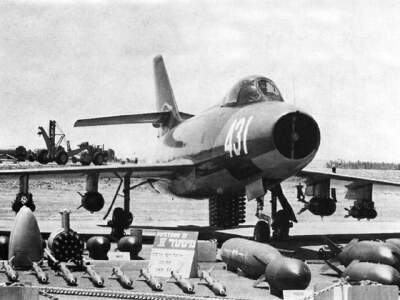
The IAF's first aircraft to cross the sound barrier, the Mystere's design originated from another type already operated by the IAF. A firm believer in evolutionary developement, Dassault designed the Mystere by fitting the Ouragan's fuselage with a 30 degrees swept wing. The result was the Mystere I whose first flight took place in February 1951. Succedded by the re-engined Mysteres II and III,
the Mystere design nonetheless suffered from poor performance and not until the advent of the Mystere IVA did the type enter frontline service. First flown on September 28th 1952, the IVA bore only an external resemblence to its predecessors with a different engine, oval fuselage, powered controls and thinner wings swept at 41 degrees. A total of 421 Mysteres IVAs have been build, serving with the French, Israeli and Indian air forces.
Israel opted to buy the Mystere in 1954, looking for aircraft to counter the MiG-15 which Israel's Arab neighbors had begun operating. The type entered service in 1956 at a time of increasing
tensions along Israel's borders resulting from increasing Arab nationality and the rapid armament of Arab
armies by Soviet weaponry. On April 11th 1956 the first four Israeli Mysteres landed at Hazor AFB, marking their arrival with a sonic boom. The new aircraft reformed the 101st "First Fighter" squadron which had been disbanded in January 1956, its P-51 Mustangs handed to the last Mustang squadron, the 116th. The Mysteres begun flying operational sorties shortly after their arrival, escorting de Havilland Mosquitos on reconnaissnce missions, but the small number of pilots available at the squadron and the delivery flights allowed for a very limited training regime and the pilots entering the approaching Suez Campaign had very little experience with the plane.
Of the 61 examples purchased only a third had been supplied by the outbreak of the Suez Campaign on October 29th 1956.
Of the three planned Mystere squadrons only the "First Fighter" had been formed by that time and the Mysteres intended for a second squadron were operated by French pilots sent to protect Israel.
The initial planning of operation "Kadesh" (Israel's part in the Suez Campaign) called for the Mysteres to attack Egyptian airfields in anticipation of an Egyptian air force attack on Israel. The Egyptian attack had
however failed to materialize and the first Mystere sorties of the war took place on the afternoon of October 29th in preparation for a large airborne assault into the heart of the Sinai. A pair of Mysteres
overflew the Mitla Pass into which Israeli paratroops were about to jump, providing real-time intelligence for the Israeli forces. Another pair overflew the Egyptian air base at Kabrit to intercept any aircraft that might have taken off to challenge the transports carrying the paratroops. While the IAF aircraft could have attacked the aircraft parked on the ground, they were under orders not to do so.
Mysteres returned to the drop zone on October 30th, flying top cover for the forces below. Although Egyptian forces on the ground had counter attacked by then, the Mysteres were once again under orders not to attack these, their sole mission remaining the protection of Israeli forces from Egyptian aircraft. During the initial fighting the Mysteres had flown 22 sorties over Kabrit and 18 sorties over the Israeli paratroops on the ground.
On the morning of October 30th 4 MiG-15s attacked the Israeli paratroops at the Mitla Pass. By the time their request for assistance had arrived back at IAF headquarters the number of aggressors had somehow inflated to 24 and the entire 101st squadron was scrambled to engaged the MiGs. Within 20 minutes of the alarm being raised 8 Mysteres arrived at the Pass to find a dozen MiG-15s at the site. Scoring the first Mystere kill, one MiG was shot down while another was damaged but managed to return to its homebase.
On October 31st IAF activity was stepped up all over the Sinai as pistoned engined aircraft which had previously been held back, could now enter the fighting. Throughout the day Mysteres flew top cover for both Israeli forces on the ground and in the air. At dawn pair of Mysteres encountered 4 Egyptian deHavilland Vampires and managed to shoot down all four of them. More dogfights took place throughout the day : at 09:00
another Mystere pair pounced on 7 MiG-15s but failed to down any of them. The same pair had however encountered another MiG upon their return home and forced it to crash land. The plane was later recovered
and returned to Israel. Another MiG was downed later in the day while two more were hit but failed to crash.
Beginning on November 1st the Mysteres also begun flying air-to-ground missions during which one Mystere piloted by the squadron commander Beni Peled (IAF chief of staff during the Yom Kippur War) was shot down. On the same day IAF Mysteres rocketed a ship which proved to be a Royal Navy Vessel, the HMS Crane.
With the war end the IAF could get back to building its Mystere force. During December 1957 a second squadron, the 109th, was finally formed at Ramat David while a third was formed at Tel-Nof in 1961. Although the Mysteres lost their seniority as Israel top interceptor to the Super Mystere on December 3rd 1958, they continued to fly both air-to-air and air-to-ground missions in the years following the war. That same month saw two Mysteres intercept two Egyptian MiG-17s which had penetrated Israel's airspace, downing one and damaging the other. On November 19th 1959 Mysteres forced a Lebanese Dragon Rapide to land at Haifa. With the arrival of more Super Mysteres and the Mirage IIICs in the early 1960s the Mysteres were relegated to the role of ground attack. Throughout the 60s they took part in the strikes against Syrian attempts to divert the waters of the Jordan River.
 back to the IDF/AF page
back to the IDF/AF page